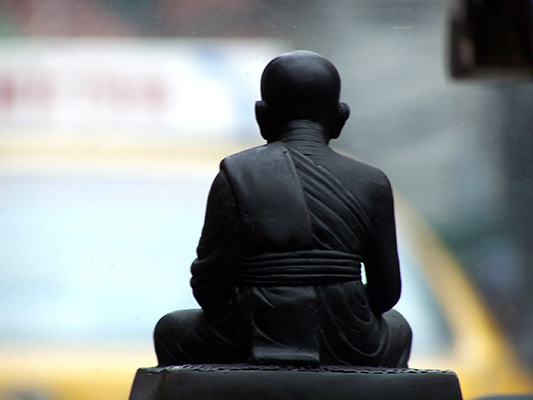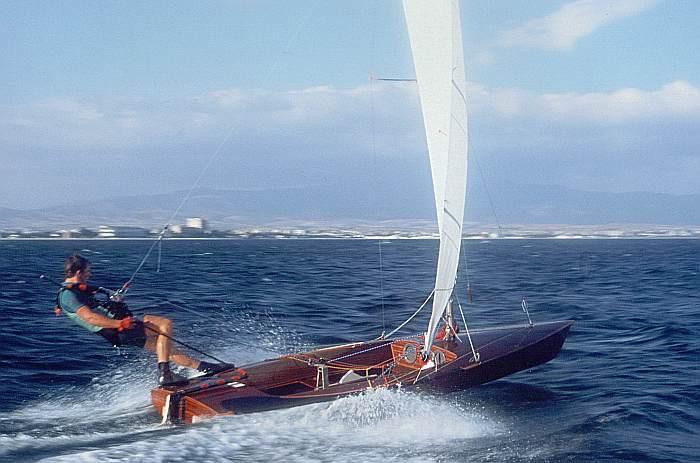Archive for the ‘Seeing Things As They Are’ Category
Self-Perspective Using Mental Time Travel
 If you’re sitting in the present, you’re sitting in a good place – you’re more mindful of what’s going on, more aware of your thinking, and more thoughtful of your actions. But there’s one thing sitting in the present can’t provide, and that’s perspective. To create perspective, to understand the hows and whys of your journey to the present, requires reflection on the past. But to self reflect without distorting the image requires separation from your present.
If you’re sitting in the present, you’re sitting in a good place – you’re more mindful of what’s going on, more aware of your thinking, and more thoughtful of your actions. But there’s one thing sitting in the present can’t provide, and that’s perspective. To create perspective, to understand the hows and whys of your journey to the present, requires reflection on the past. But to self reflect without distorting the image requires separation from your present.
Here’s an idea to create separation – an exercise in mental time travel where your past becomes your present and your present becomes your future. It goes like this: Set your mental way-back machine for five years ago, turn the crank and jump back to a five-years-ago present. From your seat in your new present (your past), erase your future (your present) to open it up to unlimited possibilities. Now, imagine a future (one of the infinite possible futures) that is identical to the one that actually happened. (But remember, you don’t know it happened, so it’s only a potential future state.) Okay. You’re now ready to mint your own perspective.
From your seat in your new present (your past), ask yourself three questions.
If your imagined future (your actual present state) came to be:
- How would you feel about your relationships with your friends, your community, and your family?
- How would you feel about your health?
- How would you feel about the alignment between your actions, values, and passions?
With your answers in hand (and I suggest you actually write them down), use your way-back machine to jump forward to the present present. Sitting in the present (the real one), read your answers (written five years ago) to the three questions above.
How do you feel about your answers? What do you like about your answers? What makes you uncomfortable? What surprised you? Write down your answers because that’s the unfiltered perspective you were looking for.
Now the valuable part – two final questions (write down the actual answers):
Taking guidance from your newly self-minted perspective:
- Going forward, while sitting in the present, what will you do more of?
- Going forward, while sitting in the present, what will you do less of?
If you are sufficiently intrigued (or confused) to try the exercise and find value in it, please pay it forward and share it with others.
And don’t forget to repeat the process every year.
Own Your Happiness
 Own your ideas, not the drama.
Own your ideas, not the drama.
Own your words, not the gossip.
Own your vision, not the dogma.
Own your effort, not the heckling.
Own your vacation, not the email.
Own your behavior, not the strife.
Own your talent, not the cynicism.
Own your deeds, not the rhetoric.
Own your caring, not the criticism.
Own your sincerity, not the hot air.
Own your actions, not the response.
Own your insights, not the rejection.
Own your originality, not the critique.
Own your passion, not the nay saying.
Own your loneliness, not the back story.
Own your health, not the irrational workload.
Own your thinking, not the misunderstanding.
Own your stress level, not the arbitrary due date.
Own your happiness.
On Independence
I know I can speak my mind, but must remember others have the same right.
I know how lucky I am, but must keep in mind others are not.
I think of my wonderful rights, but steep in the huge obligation that comes with them.
I sometimes forget I have first world problems, and know I cannot truly comprehend third world problems.
I know I didn’t have to sacrifice anything, but others willingly sacrificed everything.
I must remember that I have it good, and I have an obligation to give back.
I must remember that my independent thought isn’t necessarily right, it’s just independent.
I want to keep in front of me we’re all immigrants, we just differ in when we arrived.
I must remember that independence is fueled by diversity, and our differences must be respected and validated.
I know my kids take for their independence for granted, but so do I.
Changing Your Behavior Is Hard
 Changing your behavior is hard. Often, just wanting to change is insufficient, especially for change that runs deep. For deep change, on its own the want doesn’t cut it. What’s required is a powerful why. Why do you want to change? What’s your motivation?
Changing your behavior is hard. Often, just wanting to change is insufficient, especially for change that runs deep. For deep change, on its own the want doesn’t cut it. What’s required is a powerful why. Why do you want to change? What’s your motivation?
But all whys are not created equal with some motivations more powerful than others. Is your motivation all about you, about your family, or society as a whole? The less it’s about you the greater its hold. Clarity on why is vital because it brings staying power.
A meaningful why can help maintain much needed determination as you push away from your as-is self. And determination is crucial because saying no to your previous behavior is exceptionally difficult because it demands full acknowledgement of your true self. In an unhealthy way, changing your behavior can be thought of as an admission – in the form of actions – that your behavior has not been up to snuff. But that’s not it. Changing your behavior is an admission you value yourself enough to face a self-imposed desire to bring more goodness; you value your family enough to bring them happiness, and you value life itself enough to reduce its suffering. It’s not about fixing something that’s broken; it’s about bringing more goodness and light.
Changing your behavior is no small thing, and to make it lasting requires deep grounding. To work through distractions; to hold onto the courage; to continually add the energy all require a strangle hold on what’s truly important. So I ask you know – what’s truly important?
You can fake it for a while, but in the end, because your motivation is not grounded, you’ll revert to your previous self. And I think this is worse than simply maintaining yourself as-is. You spend precious energy forcing the behavior because there’s no grounded motivation. Also, you set expectations that the temporary new behavior is now the standard, and when you revert expectations must be reset.
Here’s a proposal: Start small – latch on to a small why and create a small change. Feel what it feels like and own it. Use your new positivity to springboard to a bigger why and a bigger change and make that one stick. Next, stand on the shoulders of the goodness to reach for a bigger, broader why and a bigger, broader change. Then, repeat.
The Illusion of Control
 When things don’t go as planned, you have a choice – look outside or look inside. Looking outside is about control and looking inside is about lack of control.
When things don’t go as planned, you have a choice – look outside or look inside. Looking outside is about control and looking inside is about lack of control.
When you look outside, what you’re saying is the universe didn’t behave per the plan, and you’re going to teach it a lesson. You’re going to tighten the screws until it does what you want; you’re going to add personal energy (probably all your energy) to lock things down; you’re going to control what must be controlled so the universe follows your plan.
The look outside approach can work, for a while. You can put your fingers and toes in all the holes; you can make sure everyone does their job; and you can be the master scheduler for the universe, but only for a while because the universe has limitless energy and you don’t. And while your control-the-world strategy looks like it’s working, it’s not – not even in the short term. The universe is playing you – it’s sucking your energy while you tread water. The universe isn’t stupid – it knows you can’t last. But at its core, the universe likes to teach; and when you fight it head-to-head, it wants to teach you about opportunity cost. While you spend all your energy wresting it to a draw, it prevents you from moving forward. It wants you to learn you have finite energy and to be thoughtful about how you spend it.
When you look inside, what you’re saying is the universe didn’t behave per the plan, and didn’t think it would. You’re going to learn from the universe and work with it; you’re going to surf the wave of the universe’s energy and carve a cross product with its momentum; you’re going to adjust your plan because you have a lack of control over the universe and most other things.
The look inside approach is effective in the long term because it works with the natural trade winds of the universe. Sailing downwind takes far less energy than tacking into the teeth of the cosmic winds, and it’s faster. This is the lesson the universe wants you to learn. But it’s not that easy. The universe constantly tests you. It changes wind direction without our consent and watches. Will you look outside or inside? Will you tack into the wind or change course and throw a huge bow wave as you go?
The toughest part isn’t the wind; it’s the other sailors. They’ve been trained over the years to tack quickly and tack often, to sail directly toward the destination regardless of the wind, even if they must grab the oars and break their backs into the wind. For those sailors, a course change is a sign of weakness – real sailors battle the wind; real sailors stay the course even if the great circle route is faster.
Thing is, plans never happen as planned, and yours is no different. Yes, control things that can be controlled, but remember – the uncontrollable can’t be controlled just because you want them to be. The universe has been around a long time and knows the ropes. It knows you don’t have control over it; it knows you only have control over how you respond to it.
When you work hand-in-hand with the universe, it rewards you, though it does so obliquely. So if your winds suddenly change and you have to sail away from your grand destination, don’t despair – that’s the universe rewarding good behavior. Double the watch and scan the horizon for the uncharted island with far more treasure than you thought possible. The universe calls that karma.
Image courtesy of YachtPals.com
It’s All Connected
 There’s a natural tendency to simplify, to reduce, to narrow. In the name of problem solving, it’s narrow the scope, break it into small bites, and don’t worry about the subtle complexities. And for a lot of situations that works. But after years of fixing things one bite at a time, there are fewer and fewer situations that fit the divide and conquer approach. (Actually, they’re still there, but their return on investment is super low.) And after years of serial discretization, what are left are situations that cannot be broken up, that cut across interfaces, that make up a continuum. What are left are big problems and big situations that have huge payoff if solved, but are interconnected.
There’s a natural tendency to simplify, to reduce, to narrow. In the name of problem solving, it’s narrow the scope, break it into small bites, and don’t worry about the subtle complexities. And for a lot of situations that works. But after years of fixing things one bite at a time, there are fewer and fewer situations that fit the divide and conquer approach. (Actually, they’re still there, but their return on investment is super low.) And after years of serial discretization, what are left are situations that cannot be broken up, that cut across interfaces, that make up a continuum. What are left are big problems and big situations that have huge payoff if solved, but are interconnected.
Whether it’s cross-discipline, cross-organization, cross-cultural, or cross-best practice, the fundamental of these big kahunas is they cross interfaces. And that’s why they’ve never been attacked, and that’s why they’ve never been solved. But with payoffs so big, it’s time to take on connectedness.
For me, the most severe example of connectedness is woven around the product. To commercialize a product there are countless business process that cut across almost every interface. Here are a few: innovation, technology development, product development, robustness testing, product documentation, manufacturing engineering, marketing, sales, and service. Each of these processes is led by one organization and cuts across many; each cut across expertise-specialization interfaces; each requires information and knowledge from the other; and each new product development project must cooperate with all the others. They cannot be separated or broken into bits. Change one with intent and change the others with unintended consequences. No doubt – they’re connected.
Green thinking is much overdue, but with it comes connectedness squared. With pre-green product commercialization, the product flowed to the end user and that was about it. But with environmental movement there’s a whole new return path of interconnected business processes. Green thinking has turned the product life cycle into the circle of life – the product leaves, it lives it’s life, and it always comes back home.
And with this return path of connectedness, how the product goes together in manufacturing must be defined in conjunction with how it will be disassembled and recycled. Stress analysis must be coordinated with packaging design, regulations of banned substances, and material reuse of retired product. Marketing literature must be co-produced with regulatory strategy and recycling technologies. It’s connected more than ever.
But the bad news is the good news. Yes, things are more interwoven and the spider web is more tangled. But the upside – companies that can manage the complexity will have a significant advantage. Those that can navigate within connectedness will win.
The first step is to admit there’s a problem, and before connectedness can be managed, it must be recognized. And before it can become competitive advantage, it must be embraced.
Own The Behavior
 The system is big and complex and its output is outside your control. Trying to control these outputs is a depressing proposition, yet we’re routinely judged (and judge ourselves) on outputs. I think it’s better to focus on system inputs, specifically your inputs to the system.
The system is big and complex and its output is outside your control. Trying to control these outputs is a depressing proposition, yet we’re routinely judged (and judge ourselves) on outputs. I think it’s better to focus on system inputs, specifically your inputs to the system.
When the system responds with outputs different than desired, don’t get upset. It’s nothing personal. The system is just doing its job. It digests a smorgasbord of inputs from many agents just like you and does what it does. Certainly it’s alive, but it doesn’t know you. And certainly it doesn’t respond differently because you’re the one providing input. The system doesn’t take its output personally, and neither should you.
When the system’s output is not helpful, instead of feeling badly about yourself, shift your focus from system output to the input you provide it. (Remember, that’s all you have control over.) Did you do what you said you’d do? Were you generous? We’re you thoughtful? We’re you insightful? Did you give it your all or did you hold back? If you’re happy with the answers you should feel happy with yourself. Your input, your behavior, was just as it was supposed to be. Now is a good time to fall back on the insightful grade school mantra, “You get what you get, and you don’t get upset.”
If your input was not what you wanted, then it’s time to look inside and ask yourself why. At times like these it’s easy to blame others and outside factors for our behavior. But at times like these we must own the input, we must own the behavior. Now, owning the behavior doesn’t mean we’ll behave the same way going forward, it just means we own it. In order to improve our future inputs we’ve got to understand why we behaved as we did, and the first step to better future inputs is owning our past behavior.
Now, replace “system” with “person”, and the argument is the same. You are responsible for your input to the person, and they are responsible for their output (their response). When someone’s output is nonlinear and offensive, you’re not responsible for it, they are. Were you kind? Thoughtful? Insightful? If yes, you get what you get, and you don’t get upset. But what if you weren’t? Shouldn’t you feel responsible for their response? In a word, no. You should feel badly about your input – your behavior – and you should apologize. But their output is about them. They, like the system, responded the way they chose. If you want to be critical, be critical of your behavior. Look deeply at why you behaved as you did, and decide how you want to change it. Taking responsibility for their response gets in the way of taking responsibility for your behavior.
With complex systems, by definition it’s impossible to predict their output. (That’s why they’re called complex.) And the only way to understand them is to perturb them with your input and look for patterns in their responses. What that means is your inputs are well intended and ill informed. This is an especially challenging situation for those of us that have been conditioned (or born with the condition) to mis-take responsibility for system outputs. Taking responsibility for unpredictable system outputs is guaranteed frustration and loss of self-esteem. And it’s guaranteed to reduce the quality of your input over time.
When working with new systems in new ways, it’s especially important to take responsibility for your inputs at the expense of taking responsibility for unknowable system outputs. With innovation, we must spend a little and learn a lot. We must figure out how to perturb the system with our inputs and intelligently sift its outputs for patterns of understanding. The only way to do it is to fearlessly take responsibility for our inputs and fearless let the system take responsibility for its output.
We must courageously engineer and own our behavioral plan of attack, and modify it as we learn. And we must learn to let the system be responsible for its own behavior.
A Healthy Dissatisfaction With Success
 They say job satisfaction is important for productivity and quality. The thinking goes something like this: A happy worker is a productive one, and a satisfied worker does good work. This may be true, but it’s not always the best way.
They say job satisfaction is important for productivity and quality. The thinking goes something like this: A happy worker is a productive one, and a satisfied worker does good work. This may be true, but it’s not always the best way.
I think we may be better served by a therapeutic dose of job dissatisfaction. Though there are many strains of job satisfaction, the most beneficial one spawns from a healthy dissatisfaction with our success. The tell-tale symptom of dissatisfaction is loneliness, and the invasive bacterium is misunderstanding. When the disease is progressing well, people feel lonely because they’re misunderstood.
Recycled ideas are well understood; company dogma is well understood; ideas that have created success are well understood. In order to be misunderstood, there must be new ideas, ideas that are different. Different ideas don’t fit existing diagnoses and create misunderstanding which festers into loneliness. In contrast, when groupthink is the disease there is no loneliness because there are no new ideas.
For those that believe last year’s ideas are good enough, different ideas are not to be celebrated. But for those that believe otherwise, new ideas are vital, different is to be celebrated, and loneliness is an important precursor to innovation.
Yes, new ideas can grow misunderstanding, but misunderstanding on its own cannot grow loneliness. Loneliness is fueled by caring, and without it the helpful strain of loneliness cannot grow. Caring for a better future, caring for company longevity, caring for a better way – each can create the conditions for loneliness to grow.
When loneliness is the symptom, the prognosis is good. The loneliness means the organization has new ideas; it means the ideas are so good people are willing to endure personal suffering to make them a reality; and, most importantly, it means people care deeply about the company and its long term success.
I urge you to keep your eye out for the markers that define the helpful strain of loneliness. And when you spot it, I hope you will care enough to dig in a little. I urge you think of this loneliness as the genes of a potentially game-changing idea. When ideas are powerful enough to grow loneliness, they’re powerful enough to move from evolutionary into revolutionary.
Drag Racing Behavior
 Our productivity-by-the-minute culture is killing us.
Our productivity-by-the-minute culture is killing us.
In business speed is king, and with it comes our short-sighted drag racing behavior. As we pull to the starting light our big engines shake and rumble, our pipes shoot flames, and our tires smoke. We stomp the throttle, accelerate to mach 1, kill the engine, and throw the chute. A quarter mile covered in record time, and champagne celebration.
But, because the pace was beyond sustainable, we can’t race again until the damage is repaired. Because it ran too hot the pit crew must pull the engine, because the torque was so outrageous the transmission must be swapped, and because the vibrations were so severe the frame must be checked for metal fatigue. But this is just another opportunity for more racing.
We externalize the setup, design the process for quick changeover, reduce waste, and focus on the vital few. No matter the pit crew doesn’t get sleep, or their families miss them. Engine swapped in record time, and obligatory celebration.
Sure, going fast is good. But business can’t be a series of back-to-back sprints. Plain and simple – people cannot sprint every day, all day. Business should be thought of as a marathon. A marathon run at a respectable pace, but a pace we’ve trained for, a pace we can sustain. With a torn hamstring the fastest sprinter makes no forward progress, and even the slowest marathoner is faster.
Sprint, yes, but only when it makes sense. Sprint, yes, but provide recovery time. Sprint, yes, but not if it will do personal harm.
Increasing speed is directionally correct, but our time horizon is too short. Instead of optimizing over a six second quarter mile, we should optimize for a marathon.
In our chase for speed’s euphoric high, our drug of choice is efficiency. Like speed, efficiency is good. But, just as speed’s time horizon is too short, efficiency’s scale of optimization is too small. We optimize locally and the net result is global sub-optimization. This is clearly an artifact of what we measure. Clearly, we must measure differently.
Every day we chase the dopamine high of efficiency, but ignore the mind-blowing power of effectiveness. If you sprint day after day, you may be efficient, but you’re definitely ineffective. Sprint every day for a month, sleep four hours a night, and spend six weeks away from your family. Are you really in a good position to make a make-or-break decision? How can you possibly be effective? I wish Finance knew how to measure effectiveness as well as it does efficiency.
As a company leader, stop sprinting. As a company leader, stop optimizing locally. As a company leader, stop focusing on efficiency. As a company leader, demonstrate and reward effectiveness. As a company leader, go home and spend time with your family.
Engineering Will Carry the Day
 Engineering is more important than manufacturing – without engineering there is nothing to make, and engineering is more important than marketing – without it there is nothing to market.
Engineering is more important than manufacturing – without engineering there is nothing to make, and engineering is more important than marketing – without it there is nothing to market.
If I could choose my competitive advantage, it would be an unreasonably strong engineering team.
Ideas have no value unless they’re morphed into winning products, and that’s what engineering does. Technology has no value unless it’s twisted into killer products. Guess who does that?
We have fully built out methodologies for marketing, finance, and general management, each with all the necessary logic and matching toolsets, and manufacturing has lean. But there is no such thing for engineering. Stress analysis or thermal modeling? Built a prototype or do more thinking? Plastic or aluminum? Use an existing technology or invent a new one? What new technology should be invented? Launch the new product as it stands or improve product robustness? How is product robustness improved? Will the new product meet the specification? How will you know? Will it hit the cost target? Will it be manufacturable? Good luck scripting all that.
A comprehensive, step-by-step program for engineering is not possible.
Lean says process drives process, but that’s not right. The product dictates to the factory, and engineers dictate the product. The factory looks as it does because the product demands it, and the product looks as it does because engineers said so.
I’d rather have a product that is difficult to make but works great rather than one that jumps together but works poorly.
And what of innovation? The rhetoric says everyone innovates, but that’s just a nice story that helps everyone feel good. Some innovations are more equal than others. The most important innovations create the killer products, and the most important innovators are the ones that create them – the engineers.
Engineering as a cost center is a race to the bottom; engineering as a market creator will set you free.
The only question: How are you going to create a magical engineering team that changes the game?
Do You Care Enough To Be Lonely?
 If you don’t feel lonely, you’ve succumbed to group-think. No, it’s worse – you’ve stopped thinking altogether. If you don’t feel lonely you’re doing it wrong.
If you don’t feel lonely, you’ve succumbed to group-think. No, it’s worse – you’ve stopped thinking altogether. If you don’t feel lonely you’re doing it wrong.
Mainstream follows mainstream – they don’t know why, they just do. In truth, mainstream likes to be lead by the nose because it’s easy, because they can get through the week without caring. But not caring is not right.
But when you care, when you really care, when you care so much it hurts, you’ve got it right. Loneliness hurts because you see habitual mistakes on the horizon; it hurts because you see bureaucracy trump thinking; it hurts because you see hierarchy squelch creativity. Put simply – it hurts because you care enough to look and you’re smart enough to see.
But take comfort in your loneliness. Though sometimes it feels they want to poke your eyes out, deep down companies want you to see. Sure, they’re afraid of the ruckus, but they want you to wrestle with the familiar. Yes, they won’t sanction your detectiveness, but they want you to investigate the crime scene. Absolutely – though with plausible deniability – they want your inner Nostradamus to conger the future.
Every-day-all-day loneliness is too much, but a low dose is good. 100% loneliness festers into anger, but now-and-again loneliness is healthy.
Take stock in your loneliness – it’s a sign your brain is turned on. And it’s a sign you care.

 Mike Shipulski
Mike Shipulski